|
Artificial Life: The Coming Evolution |
|
An Overview |
Artificial Life
Definition:
The Study Of Man-Made Systems That Exhibit Behaviors Characteristic of Natural Living Systems
Implications:
Study of life as it could be
Formal basis for life
Bottom-up synthesis
Emergent behavior
No global controller
Essential Point:
Artificial life studies natural life by attempting to capture the behavioral essence of a living organism
Essential Tool: Computer
(Models on-going behavior not final result)
Essential Features:
Computer Based Alife Models
Consist of population of simple
programs or specifications
No
single program that directs all other programs
Each program controls simple entity in environment
No global rules
Any behavior at levels higher than program is emergent
Essential Insight: Nature is fundamentally parallel
Historical Roots of Alife
History of Machines
Rendering in hardware actions previously carried out solely by muscle and brain
Early Models: Reflect technology of era
Earliest: Statues/Paintings -- Captured static forms
1st C: Hero of
· Invented automated theatres that used analogue programming to control the puppets, doors, lights, and sound effects.
· Performed a play lasting 10 minutes and was operated by a complex system of ropes and drums that might be considered to be a means of deciding which parts of the mechanism performed which actions and when

When a fire is lit, the air in the hollow altar expands and drives out the liquid contained in the altars pedestal. Then, the liquid passes through tubes in the figure bodies and appears to be poured by the figures.
14th C: Clockwork regulation schemes
17th-18th C: Clockwork mechanisms for mechanical figures
Peak: Mechanical duck of Vaucanson -- gilded copper duck that ate, splashed about and
digested food



Results: Programmed control
Abstraction of Logical Form of Machine
Formal Application of Logic to Mechanical Process of Arithmetic
Church, Kleene, Godel, Turing, Post -- Logical Sequence of Steps
Realization: An objects dynamical behavior is governed by an abstract control structure -- a program
Implication: Logical form separate from material of construction (e.g. electronic vs mechanical watch)
And: Aliveness is property of logical form
Today: Algorithm is formal equivalent of machine
Formal Limits of Machine Behavior
Computability in Principle
Certain behaviors are uncomputable (i.e. behaviors for which no formal specification exists)
e.g. Turing's Halting Problem
Formally
specify a machine
Feed
machine a description of another machine,and
its initial state
Ask first machine, by inspection, to determine whether or not second machine will stop
Computability in Practice
A formal specification may exist in principle, but we do not know how to specify in practice
In General
Can not derive behavior from specification nor specification from behavior
Generation of Lifelike Behavior
John Von Neumann- First Computer Approach
· Thought Experiment: Kinematic Model
§ Machine on surface of pond with machine parts
§ Given description of any machine, it will construct it
§ Given design of self, will copy self
Question: Is this self-replication?
Answer: No!
Fix: Machine must copy description of self into offspring
Note: Constitutes true self-reproduction
Problem: Does not separate logic from material of process
Solution: Cellular Automata (CA)
Cellular Automata Model -- Regular lattice of finite automata
Characteristics:
Automata
can be in only one of a finite number of states
Transitions from one state to another is governed by state transition tables
Input derived from states of automata and neighboring sites
All automata in lattice obey same rules
e.g.
Rules:
If a cell is dead and has three neighbors at time t, it will become alive at time t+1
If an alive cell has only one neighbor or more than three neighbors at time t, then at t+1 it will die
Example: http://psoup.math.wisc.edu/mcell/mjcell/mjcell.html
Results of CA Work
Embedded logical equivalent of his kinematic model within CA using 29 states/cell
Constructed proof that self-reproduction was achievable by machines
Showed that information contained in design of machineis used in two different ways
Interpreted -- As instructions to be executed in the construction of offspring
Uninterpreted -- As passive data to be duplicated to form a description given to the offspring
Langton
Self-Reproducing Cellular
Automata (e.g. http://necsi.org/postdocs/sayama/sdsr/java/)

n Sheath: Outer shell housing gene sequence.
n Genes: 7s (straight growth) and 4s (turning).
n Tube: core (1) states within sheath.
n Arm: extensible loop structure for replication.

n Loops composed of phenotype and genotype:
-Phenotype: inner and outer sheath of loop
-Genotype: gene sequence within loop
n Define loop species by phenotype + genotype.
n Sufficient information for loop reconstruction.
For details : See http://necsi.org/postdocs/sayama/sdsr/
Other Work
Weiner -- Feedback control
Walter -- Electronic Turtles
Capable
of apparently complex lifelike behavior, including feeding (charging) when
"hungry", pursuing lights, and flocking behaviour
in groups.
Walter
called his robot a turtle because it had a turtle-like "shell" on top
to protect its electronics.

Stahl -- Models of Cellular Activity/Metabolism/Reproduction
Lindenmayer -- Models of Cellular Activity and Development
Biological Automata
Question:
Is it possible to abstract logical form of an organism from it's biological wetware?
Definitions:
Genotype -- Specification of machinery (complete set of low level rules)
Phenotype -- Behavior of machinery (structure/behavior that emerges in space and time as a result of the interpretation of the genotype in context of particular environment
Morphogenesis -- Process by which phenotype develops through time under direction of phenotype
Genes -- individual genetic instructions
Problem: Unpredictability of Phenotype From Genotype
General Case:
Cannot determine by inspection alone any non-trivial feature of phenotype that will emerge from a given genotype in context of particular initial configuration
Why? - Non-linear interactions
Solution: Trail-and-error or Natural Selection
General Approach To Building Genotype/Phenotype Systems
(Recursive Generated
Objects)
Appeal:
Arises naturally from Gtype/Ptype distinction
local development rules - recursively defined - Gtype
developing structure - recursively generated - Ptype
Under This Method:
Object is structure that has subparts
System rules specify how to modify parts and are usually sensitive to context
Lindenmayer Systems (Wikipedia)
(Example)
·Set of rules for recursively rewriting symbols
·E.G. Simple Linear Growth
·Rules for Gtype:
1. A ->
CB
2. B -> A
3. C -> DA
4. D -> C
Time
Structure
0
A (Seed)
1
CB
2
DAA
3
CCBCB
4
etc.
See http://algorithmicbotany.org/papers/
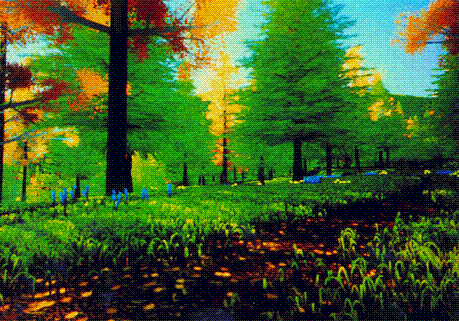
A forest scene by Reeves,1984
Pixar
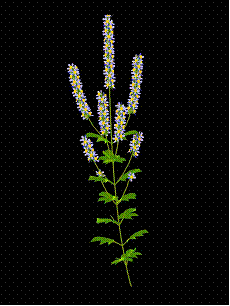

A mint Apple twig
From
The Algorithmic Beauty of Plants, P. Prusinkiewicz (Book download)
(Properties)
- Can construct branching patterns
- Can be context free or context sensitive
- Context sensitive rules provide for possibility of nonlinear interactions among parts (feedback control)

Genuine Life In Artificial Life Systems
- Constituent Parts of Alife System Are Different Kinds Of Things From Their Natural Counterparts
But
· Emergence Behavior They Support is Same Kind of Thing
E.G. Boids (Craig Reynolds examples)

Local Rules:
Maintain minimum distance
from other objects in environment
Match velocity of Boids in neighborhood
Move toward perceived center of mass of boids in
neighborhood
Result: True Flocking Behavior
Artificial in Alife Refers to Component Parts Not Emergent Processes
Big Claim:
· Properly Organized Sets of Artificial Primitives Carrying Out Same Functional Roles As The Biomolecules in Natural Systems
· Will Support A Process That is "Alive" in The Same Way That Natural Organisms Are Alive
Therefore: Artificial Life Is Genuine Life -- Only Different!
What Are Properties of Life?
1. Pattern in space-time
2. Self-reproduction
3. Information Storage of a Self-representation
4. Metabolism Which Converts Matter And Energy From Environment To Pattern of Activity of The Organism
5. Functions Interactively With Environment
6. Interdependence of Parts
7. Stability Under Perturbations
8. Ability To Evolve
Are Computer Viruses Life Forms?
|
Biological |
Computer |
|
Length of Genetic Material Injects Code Into Cell Cell Becomes Factory Replicating the Virus |
Length of Machine Code Copies Code Into Program When Code Is Executed, Infected Program Spreads Virus Further |
Are Viruses Real Life Forms?
1. Viruses are Pattern in Space-time
2. Viruses Self-reproduce
3. Information Storage of a Self-representation is Used For Virus Self-replication
4. Virus Metabolism -- Uses Electricity of Computer
5. Functions Interactively With Environment By Examining Computer Resources
6. Interdependence of Parts -- Can't Divide Virus Into Pieces
7. Stability Under Perturbations -- Virus Can Defeat Anti-Virus and Copy Protection Schemes; Virus Can Adjust to insufficient Memory
8. Ability To Evolve
9. Growth -- Viruses Exhibit Growth By Filling Up Disk Space
Other :
- Can Exist In Well Defined Ecological Niches
- Some Exhibit Predatory Behavior
- Some Exhibit Territorial Behavior
Evolution And Self-Organization
Biological Evolution Is Just One Example of The Tendency of Matter To Organize Itself As Long As Proper Conditions Prevail
Middle 1800's -- H. Spenser
- Evolution Is A Change From Incoherent Homogeneity to Coherent Heterogeneity
- Evolution Gives Rise To:
- Increasing Differentiation (Specialization of Functions)
- Integration (Mutual Interdependence and Coordination of Functions of The Structurally Differentiated Parts)
Self-Organization Simulation by Cellular Automata
(Greenberg-Hastings Model)
· A classical model of excitable media was introduced 1978 by Greenberg and Hastings.
· Two-dimensional square grid G=Z2.
· Three Indices:
R, range of interaction
T, Threshold needed for excitation
K, Number of available states
· Rules:
o Each cell on lattice Painted One of K colors arranged in color wheel, 0 -> K-1
o Colors advance in only one direction around color wheel
o Color either advance automatically or by contact
o Advance by color k at site x means that k -> k + 1 IFF at least T neighboring sites within range R of x have values K+1 mod k
o For GH model, only state 0 advances by contact, all other advance automatically
· Neighbors are the five nearest cells, including the cell itself.
Random Seed Converged
Dynamics


Example: http://psoup.math.wisc.edu/mcell/mjcell/mjcell.html
Reaction-diffusion systems and
Morphogenesis
From: Visualization of solid reaction-diffusion systems, Chambers, P.; Rockwood, A., IEEE
Computer Graphics and Applications, Volume 15, Issue 5, Sep 1995 Page(s):7 - 11
To explain biological
morphogenesis, Alan Turing proposed a system of chemical substances, morphogens, that
react together and diffuse throughout the developing tissue.
·
The
cells within the tissue act as sites for this diffusion and reaction.
·
The
initial state of the morphogen concentrations may be
random or homogeneous.
·
However,
after the system has evolved, macroscopic concentration patterns appear in the
reacting chemicals.
·
Local
concentration gradients modify the diffusion rates of the morphogens,
which react to increase or decrease the amount within individual cells.
The equations describing the two-morphogen reaction-diffusion model are

where:
a and b are the concentrations of two diffusing morphogens;
F and G are functions determining the production rate
of a and b;
Da and Db are diffusion rate constants;
![]() and
and![]() are the Laplacians
of a and b.
are the Laplacians
of a and b.
- A system to approximate the model is built upon an array of cells
through which morphogens a and b may diffuse.
- Within each cell, a
and b are created or
destroyed according to F and G.
Discretization of


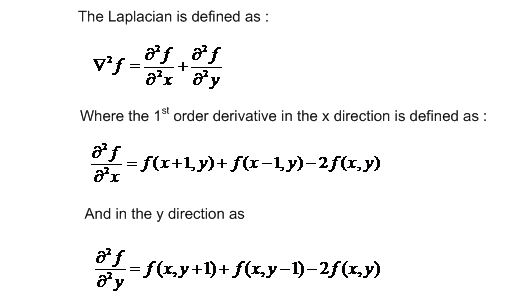
- Turing proposed a discrete system to solve the above equations:

where:
ai and bi
are morphogen concentrations in a one-dimensional
array of cells;
βi represents the natural variation between individual
cells;
s is the reaction rate constant.
1D reaction-diffusion systems
When a 1D reaction-diffusion system evolves, the
result is a set of cells whose morphogen
concentrations exhibit a large-scale pattern with respect to the dimensions of
an individual cell.
The morphogen
concentrations, with different colors for different morphogens,
are plotted along the y-axis
and the cell positions along the x-axis.
- Figure shows the morphogen
concentrations for the 1D reaction-diffusion system.
- Morphogen a
is plotted in red and morphogen b in green. The zero-morphogen baseline is blue.
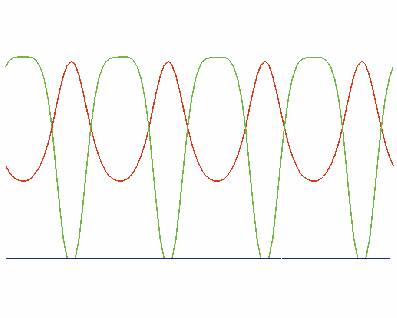
·
Simulation
uses the following values: Da = 0.25, Db = 0.0625, ai = 4.0, bi = 4.0, βi = 12.0
? 0.05 (randomly selected for each i), s = 0.00625, number of cells = 100, iterations = 60,000.
·
This
defines a homogeneous starting condition.
·
After
60,000 iterations, the system acquires a macroscopic organization with
symmetric highs and lows of morphogen concentration.
·
The
peaks of morphogen as
concentration match the lows of morphogen bs
concentration, and vice-versa.
·
This
is characteristic of a two-morphogen system; high
concentrations of morphogen a inhibit further similar regions
from forming close by.
2D reaction-diffusion systems
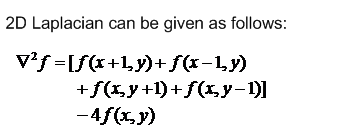
In Matrix form:
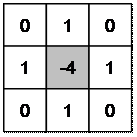
The discrete reaction-diffusion equations extend to
two dimensions:

- Cells are arranged on a square grid.
- Each cell diffuses to and from its four neighbors, with periodic
boundary conditions.
- Visualizing 2D systems uses morphogen intensity mapping
- 2D grid is shaded according to the amount of a particular morphogen contained in the corresponding cell.
- Dark areas are regions of low morphogen
concentration, while lighter areas represent higher concentrations.
- The choice of color is arbitrary.
- Initial conditions of a 2D reaction-diffusion system are the same
as the 1D case, except s
= 0.03125.
- The system consists of 80 by 80 cells and runs for 20,000
iterations.
- Intensity map visualization of the
reaction-diffusion data.
- The areas of minimum concentration form clearly defined regions
with smooth transitions to adjacent cells.
- Patterns such as this underlie much of the work on mammalian coat
patterns.
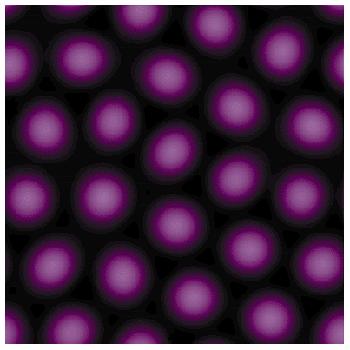
Imposition of external control
upon the diffusion parameters Da and Db.
The anisotropy biases the
system to form stable domains parallel to the direction of the greatest b morphogen
diffusion rate. Note the resemblance to zebra stripes.
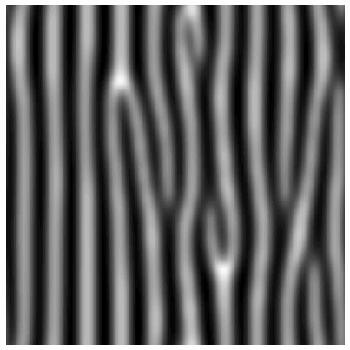
Belousov-Zhabotinsky reaction
Oscillatory Reactions
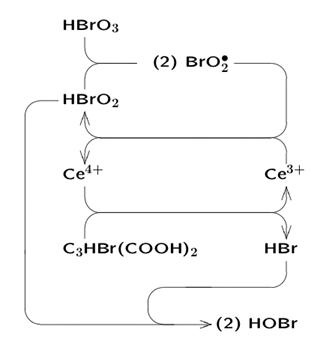

Slime Mold
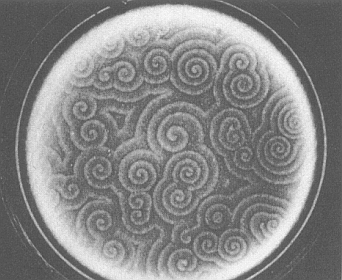
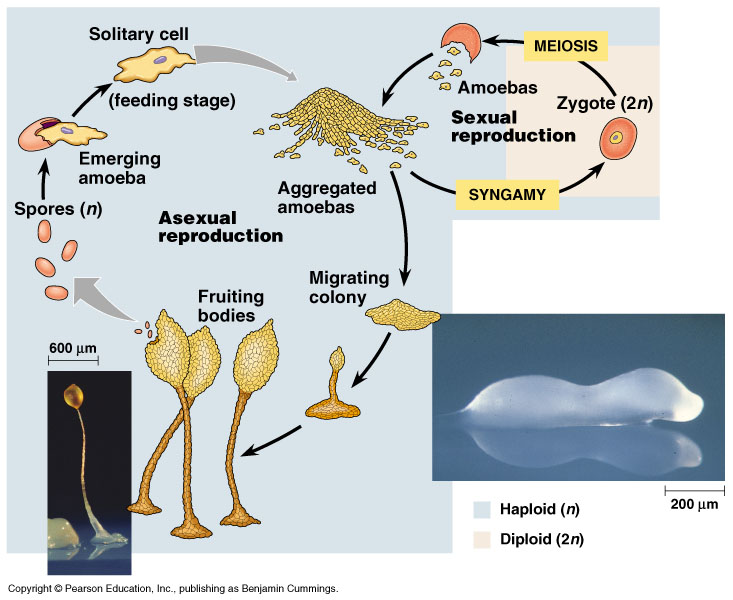
Whats Next?